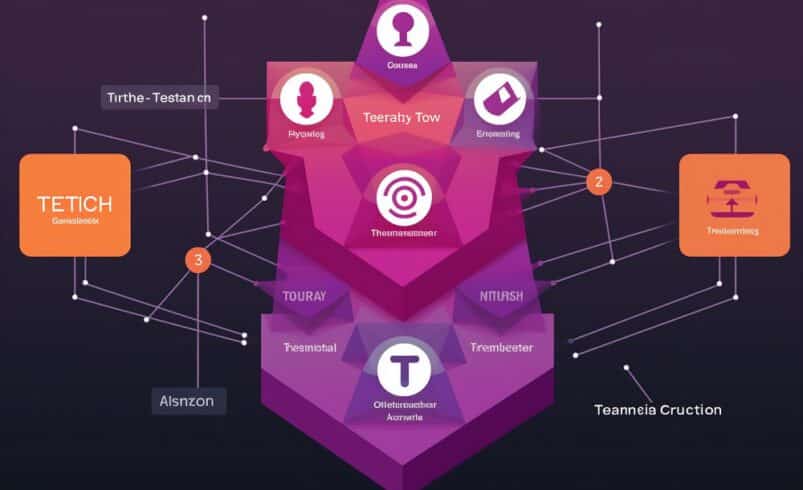Nonce In Blockchain Technology: All You Need To Know

Table of Contents
Blockchain technology has revolutionized various industries, offering a secure and transparent way to record transactions. At the heart of this innovation lies the concept of a nonce, a crucial element in ensuring the security and integrity of the blockchain.
This guide explores nonces and their significance in blockchain security.
Nonce’s Responsibilities
A nonce, abbreviated from “number used once,” is a unique number assigned to a block during mining. This mining process is integral to the proof-of-work (PoW) consensus mechanism, a fundamental aspect of many blockchain networks.
Miners, the key players in the blockchain ecosystem, manipulate the nonce as part of a cryptographic puzzle to produce a hash value that meets specific requirements. Why is this process so important? It ensures the security of the blockchain.
The correct nonce is essential for validating a block’s legitimacy. It plays a pivotal role in creating each block, preventing malicious actors from tampering with the data stored in the blockchain. The mining process involves a trial-and-error method.
Miners search for the correct nonce by continuously adjusting it until they uncover a hash that satisfies the specified criteria. This iterative process, known as mining, is vital in upholding the blockchain network’s consensus, security, and integrity.
Security Aspects Associated With Nonce
One of the primary functions of the nonce is to prevent double-spending, a threat to the integrity of digital currencies. Blockchain technology mitigates this risk by requiring miners to perform computationally intensive tasks to discover a specific nonce.
This ensures that each transaction is uniquely confirmed and prevents fraudulent manipulation. Additionally, the nonce plays a role in defending blockchains against Sybil’s attacks. These attacks involve flooding the system with fictitious identities, potentially compromising the network.
The nonce contributes significantly to maintaining the immutability of blocks within the blockchain. Any attempt to alter the content of a block necessitates recalculating the nonce, a daunting task that strengthens the integrity of the blockchain and deters tampering.
Utilization Of Nonce In Bitcoin Network
In the Bitcoin network, miners employ the nonce in a trial-and-error process to find a specific hash that meets the network’s difficulty criteria. This successful discovery of the appropriate hash validates and adds a new block to the blockchain.
Here’s a step-by-step breakdown of how the nonce is calculated and utilized in Bitcoin mining:
- Block setup: Miners gather pending transactions to assemble a new block.
- Nonce addition: A unique nonce is put into the block header.
- Hashing attempt: Bitcoin miners use the SHA-256 hashing algorithm to hash the block.
- Difficulty assessment: The resulting hash is compared to the network’s difficulty target.
- Iterative process: Miners adjust the nonce continually until they find a hash that meets the difficulty criteria, thus validating the block for addition to the blockchain.
Dynamic Adjustment Of Difficulty
When the network’s computational power increases, the difficulty of finding a valid nonce in the Bitcoin blockchain rises, demanding more processing power to discover a suitable nonce. Conversely, decreasing the network’s processing capacity leads to a lower difficulty level, making block creation easier.
Nonces And Their Significance
Nonces, regardless of their forms, serve distinct purposes across diverse landscapes. While prominently used in blockchain technology, different types of nonces cater to specific security and functionality needs in cryptography.
One prevalent type is the cryptographic nonce, commonly employed in security protocols to thwart replay attacks. Each transaction generates an exclusive value, preventing malicious actors from reusing data to manipulate the system.
Another type is the cryptographic hash function nonces. These nonces alter the input in hashing algorithms to produce different output hashes, ensuring data uniqueness and conflict avoidance.
Understanding these diverse contexts is crucial since nonces, in their various forms, serve different purposes across computer science and cryptography, contributing to data integrity and security in their respective domains.
Distinguishing Hashes From Nonces
A hash acts like a fingerprint for data, providing a fixed-size output based on input data. It serves as a unique identifier, representing the data in a condensed form. Conversely, a nonce is a variable used in the security puzzle of creating digital currency within a blockchain.
In blockchain, miners utilize the nonce as a variable to generate hashes that meet specific requirements. The nonce manipulation by miners aims to produce hashes that adhere to predetermined criteria. The resulting hashes, representing the block’s data, are crucial in validating and adding blocks to the blockchain.
Security Considerations And Preventing Nonce-Related Attacks
One notable attack is the “nonce reuse” attack, where a malicious entity reuses a nonce during a cryptographic process, compromising the network’s security attributes. This poses a significant threat to systems reliant on unique nonces, such as digital signatures and encryption.
Another typical attack is the “predictable nonce” attack, where hackers exploit predictable patterns in nonces to anticipate and manipulate cryptographic operations. Additionally, “stale nonce” attacks involve tricking systems using outdated or previously valid nonces to deceive the system.
Mitigating nonce-related vulnerabilities requires robust preventive measures. Ensuring the uniqueness and unpredictability of nonces is paramount. In addition, proper implementation of random number generation prevents nonce repetition. Moreover, protocols should incorporate mechanisms to detect and reject reused nonces.
Conclusion
Continual upgrades to cryptographic libraries and protocols and vigilant monitoring for irregular nonce usage patterns bolster defenses against evolving attack vectors. Furthermore, employing security best practices and adhering strictly to standardized cryptographic algorithms are imperative in mitigating nonce-related vulnerabilities.
Time Crypto Market offers content visibility for dozens of crypto enterprises, and you can be a part of our network! Reach out to us on our telegram chat for inquiries. The nature of cryptocurrencies is highly unpredictable; always perform your due diligence before any investment. Several articles on our site come from guest contributors or are commissioned pieces, not originating from Time Crypto Market's in-house writers. The perspectives shared in these articles might not necessarily align with those of Time Crypto Market. We do not assume responsibility for the veracity, caliber, promotions, offerings, or any other elements presented on our platform. Consult our comprehensive terms of service and disclaimer for more details.








